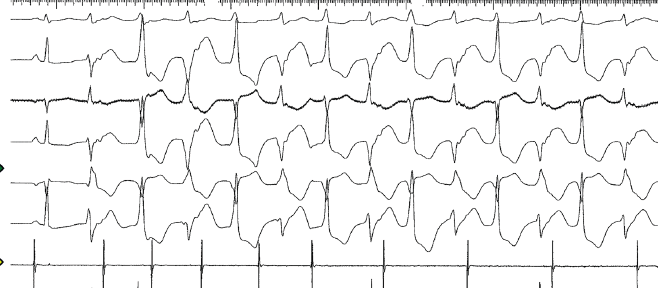Andersen-Tawil Syndrome, a differential of bidirectionalventricular tachycardia: a case report
DOI:
https://doi.org/10.47487/apcyccv.v5i3.378Keywords:
Andersen Syndrome, Long QT Syndrome, Tachycardia, Ventricular, MutationAbstract
We present the case of a patient with Andersen-Tawil syndrome (ATS), a rare genetic disorder characterized by the presence of ventricular arrhythmias, skeletal dysmorphic features, and periodic muscle paralysis,. The diagnosis was delayed due to the non-simultaneity of symptom presentation. The report highlights the importance of investigating neurological symptoms in the presence of ventricular arrhythmias of unclear origin or cardiac symptoms in patients with periodic paralysis. The diagnosis was confirmed by the identification of a mutation in the KCNJ2 gene (c.224C>T(p.Thr75Met)); this specific mutation has not been reported in the gnomAD database, suggesting a minor allele frequency (MAF) of less than 1%. The patient is currently managed pharmacologically with a betablocker and remains free of arrhythmias.
Downloads
References
Weir RA, Petrie CJ, Murday V, Findlay IN. Andersen-Tawil syndrome. Int J Cardiol. 2011;148(1):e13-5. doi: 10.1016/j.ijcard.2009.01.057.
de Vera McMullan P, Corella Aznar E, Granados Ruiz MÁ. Andersen-Tawil syndrome: A long QT syndrome with variable expression. Med Clin (Barc). 2024;162(6):309-311. English, Spanish. doi: 10.1016/j.medcli.2023.10.021.
Rocha-Arrieta MC, Arias-Díaz A, Quiróz-Romero CA, Rocha-Arrieta Y. [Catecholaminergic polymorphic ventricular tachycardia in adolescents: a clinical, electrocardiographic and genetic diagnosis]. Arch Peru Cardiol Cir Cardiovasc. 2021;2(3):205-210. Spanish. doi: 10.47487/apcyccv.v2i3.151.
Pérez-Riera AR, Barbosa-Barros R, Samesina N, Pastore CA, Scanavacca M, Daminello-Raimundo R, et al. Andersen-Tawil Syndrome: A Comprehensive Review. Cardiol Rev. 2021;29(4):165-177. doi: 10.1097/CRD.0000000000000326.
Donaldson MR, Jensen JL, Tristani-Firouzi M, Tawil R, Bendahhou S, Suarez WA, et al. PIP2 binding residues of Kir2.1 are common targets of mutations causing Andersen syndrome. Neurology. 2003;60(11):1811-6. doi: 10.1212/01.wnl.0000072261.14060.47.
Statland JM, Fontaine B, Hanna MG, Johnson NE, Kissel JT, Sansone VA, et al. Review of the Diagnosis and Treatment of Periodic Paralysis. Muscle Nerve. 2018;57(4):522-530. doi: 10.1002/mus.26009.
Almarzuqi A, Kimber S, Quadros K, Senaratne J. Bidirectional Ventricular Tachycardia: Challenges and Solutions. Vasc Health Risk Manag. 2022;18:397-406. doi: 10.2147/VHRM.S274857.
Gutiérrez LK, Moreno-Manuel AI, Jalife J. Kir2.1-NaV1.5 channelosome and its role in arrhythmias in inheritable cardiac diseases. Heart Rhythm. 2024;21(5):630-646. doi: 10.1016/j.hrthm.2024.01.017.
Vivekanandam V, Jayaseelan D, Hanna MG. Muscle channelopathies. Handb Clin Neurol. 2023;195:521-532. doi: 10.1016/B978-0-323-98818-6.00006-6.
Tan SV, Matthews E, Barber M, Burge JA, Rajakulendran S, Fialho D, et al. Refined exercise testing can aid DNA-based diagnosis in muscle channelopathies. Ann Neurol. 2011;69(2):328-40. doi: 10.1002/ana.22238.
Kostera-Pruszczyk A, Potulska-Chromik A, Pruszczyk P, Bieganowska K, Miszczak-Knecht M, Bienias P, et al. Andersen-Tawil syndrome: report of 3 novel mutations and high risk of symptomatic cardiac involvement. Muscle Nerve. 2015;51(2):192-6. doi: 10.1002/mus.24293.
Johnson JN, Tester DJ, Perry J, Salisbury BA, Reed CR, Ackerman MJ. Prevalence of early-onset atrial fibrillation in congenital long QT syndrome. Heart Rhythm. 2008;5(5):704-9. doi: 10.1016/j.hrthm.2008.02.007.
Zhang L, Benson DW, Tristani-Firouzi M, Ptacek LJ, Tawil R, Schwartz PJ, et al. lectrocardiographic features in Andersen-Tawil syndrome patients with KCNJ2 mutations: characteristic T-U-wave patterns predict the KCNJ2 genotype. Circulation. 2005;111(21):2720-6. doi: 10.1161/CIRCULATIONAHA.104.472498.
Davies NP, Imbrici P, Fialho D, Herd C, Bilsland LG, Weber A, et al. Andersen-Tawil syndrome: new potassium channel mutations and possible phenotypic variation. Neurology. 2005;65(7):1083-9. doi: 10.1212/01.wnl.0000178888.03767.74.
Eckhardt LL, Farley AL, Rodriguez E, Ruwaldt K, Hammill D, Tester DJ, et al. KCNJ2 mutations in arrhythmia patients referred for LQT testing: a mutation T305A with novel effect on rectification properties. Heart Rhythm. 2007;4(3):323-9. doi: 10.1016/j.hrthm.2006.10.025.
Tani Y, Miura D, Kurokawa J, Nakamura K, Ouchida M, Shimizu K, et al. T75M-KCNJ2 mutation causing Andersen-Tawil syndrome enhances inward rectification by changing Mg2+ sensitivity. J Mol Cell Cardiol. 2007;43(2):187-96. doi: 10.1016/j.yjmcc.2007.05.005.
Wu L, Fang Y, Zhang BR. World J Emerg Med. 2020;11(4):267-269. doi: 10.5847/wjem.j.1920-8642.2020.04.012.
Maffè S, Paffoni P, Bergamasco L, Dellavesa P, Zenone F, Baduena L, et al. Therapeutic management of ventricular arrhythmias in Andersen-Tawil syndrome. J Electrocardiol. 2020;58:37-42. doi: 10.1016/j.jelectrocard.2019.10.009.
ClinicalTrials.gov [Internet]. N-of-1 in ATS and MEPPC. Identifier: NCT06205550. Bethesda, MD: NIH; 2024 [citado el 9 de marzo del 2024]. Disponible en: https://clinicaltrials.gov/study/NCT06205550?viewType=Table&page=11&rank=102

Downloads
Published
Issue
Section
License
Copyright (c) 2024 The journal is headline of the first publication, then the author giving credit to the first publication.

This work is licensed under a Creative Commons Attribution 4.0 International License.














